#XVIth century
Explore tagged Tumblr posts
Text

Palais Granvelle - Besançon
#granvelle#architecture#besancon#painted tiles#palais granvelle#charles quint#tuiles vernissees#imperiale#roof#toit#besac#doubs#franche-comte#boucle#XVIe siecle#XVIth century
37 notes
·
View notes
Text






A Schlachtschwert, late XVIth/early XVIIth century.
Spring steel blade, oil-blacked cross and pommel made of mild steel, and vegetable tanned leather over wood for both grip and the sleeve thing that comes over the ricasso. All hand-forged, filed, carved and decorated.
165.2 cm long and about 10 mm thick at its base, tapering to about 2 mm near the point ; cross span is 39 cm, weight is 2951 grams, and point of balance is right at the lugs, as should be.
Exploring yet another variant of cross and pommel style here.
Contrarily to the popular belief, and even though they ended up in such a role in later times, these were not just processional swords, but powerful weapons of war. Now at five thousand euros, shipping not included.
125 notes
·
View notes
Text

“Wall Tile Mosaic of Enamelled Earthenware, Persian art XVIth century”
113 notes
·
View notes
Text



Some kind of "everything is the same but fashion is more XV-XVIth century inspired" AU - part 1/?
(a few elements are based on Landsknecht armors/clothing, because they were mercenaries too, you know? But I've been kind and made the palette less... Everything. You're welcome, Fenris.)
#Now I want those green sleeves so bad#Anyway I'm not aiming for perfect accuracy - it's funnier to take inspiration and then be creative with it imho#And this is why you are not getting Fenris in bright yellow/red striped clothes today - but I can be persuaded#Btw!! DA2 is such a renaissance story/narrative#Ask me more about it at your peril#I think this is also subconsciously due to the fact that I was doing a Borgia rewatch while playing it for the first time#One year ago :')#clip studio paint#mixed media art#sketch#dragon age fanart#da fanart#Dragon age#Fenris#dragon age fenris#da2#digital illustration#csp#da2 fenris
31 notes
·
View notes
Text
Don't want to stir any drama up, but to anyone claiming that The Thaumaturge is "written like Disco Elysium", I must say... I don't see it that way at all. First and foremost, I view The Thaumaturge as a work infused with the spirit of Polish XIXth century literature. The mood of this game deeply reverberates with the nostalgia of the Romantic national mythology, wistful allusions to the January Insurrection that the younger generations still bled from, incisive social analysis of the Positivist novels, and a certain dreary, bleak and often darkly realistic quality of Żeromski, who created closer to the game's timeline.
Inside the game itself, there are traces of secret meetings where you can read "patriotic" literature forbidden in the Russian Partition, Polish folk legends on the bazaar, collectible quotes from writers of the age.
As Wiktor says when riding the train to Warsaw with Rasputin, that place lives and breathes hope of a new life and hope for Poland's revival against the suppression and the cultural erasure under the Russian Partition. Even the covenant ending happens for a patriotic premise, with a subtle throwback to the mythology of the First Commonwealth that took pride in its religious tolerance back in the XVIth century (even if its treatment of the Commonwealth nations has been viewed in a less than favorable light through the post-colonial lens), since it connects a Muslim Tatar (Emir), a religious Jew (Samira/ Sara), a self-proclaimed "circumcized atheist" (Ariel) and whatever Wiktor declares as (the options hinted throughout the story are either Orthodox or lapsed/ atheist since I haven't found any traces of secret Catholic masses, unless I missed something) in their common goal of a Poland reborn that would let each of them live free as thaumaturges, as believers of their respective religions, as Poles and as humans.
I don't know if Disco Elysium has similar currents of Estonian identity discussed in it, but I don't see The Thaumaturge as similar to it in writing. The thing that connects these two games is mostly the choice to marry introspection, combat and exploration into something that leaves the writing a lot of room to breathe. As for the writing itself, I instantly see the signature of our XIXth-century discourse that simply cannot be divorced from the matters of maintaining national identity while Poland could not to be found on the map of Europe. I see works that form our school curriculum in literature from the period: Słowacki, Prus, Norwid, Reymont, Żeromski, Konopnicka, Zapolska etc. I see them choosing the Russian partition as a place that is also likely the closest to the game's writers personally. If you can understand Polish subtitles, the linguistic stylization to the late Secession/ Interwar period Polish (which, admittedly, isn't that different from today's norms) and the local vernacular is spot on.
This game has a mention of one Ignacy Wokulski ffs.
#the thaumaturge#thaumaturge meta#polish literature#I haven't been to school in almost 20 years but at least my literature education was solid#to think of it a lot of our curriculum is centered on the Russian Partition specifically#because the great bards of Romanticism hailed from Kresy#I now lowkey wish something like The Thaumaturge was created about Greater Poland and Galicja too#not that the DE writing can't be poignant#it's just a very different brand to me
12 notes
·
View notes
Photo

Scrapbook containing Italian etchings of the XVIth and XVIIth centuries. 16th–17th century. Credit line: Harris Brisbane Dick Fund, 1926 https://www.metmuseum.org/art/collection/search/366511
#aesthetic#art#abstract art#art museum#art history#The Metropolitan Museum of Art#museum#museum photography#museum aesthetic#dark academia
8 notes
·
View notes
Text
Kotoko's justice and her motivations theory
While Kotoko is still pretty mysterious, there are some parts in Milgram that could hint at her inner workings and why she does the things she does. Here mostly content from her mvs will be discussed. Be careful as this theory discusses sensitive topics.
CW: discussion of kidnapping and SA
The wolf imagery and its possible multiple meanings
Before Deep Cover came out, one theory regarding the wolves in Harrow is that they represented Kotoko’s allies in her actions.
Now that it’s out, it seems more likely Kotoko was acting entirely alone for her actions (so more of a lone wolf image rather than hunting with a pack).
Kotoko has strong ties with both regular wolves and also werewolves, with distinct symbolism for each.

Jacques Roulet was the name of a French man who was accused of being a werewolf in the late XVIth century (source: https://www.historydefined.net/the-french-werewolf-panic/).

The wolf imagery seems to be associated with Kotoko’s sense of justice and her preference for working alone, unlike the werewolf imagery that represents her excesses of violence (imo). This is seen mostly in Harrow, featuring wolves and an overall positive view of Kotoko, then in DC which has her more questionable sides and the whole werewolf image.
Still, I feel like there’s more to the wolves regarding Kotoko’s case.
This article (https://www.psychologies.com/Therapies/Psychanalyse/Dictionnaire-des-reves/Loup) talks about some of the symbolisms of wolves, including violence, aggressivity, etc. This is psychoanalysis so take it with a grain of salt though.
One passage that struck me in particular was this one:
“Most of the time, in dreams, the wolf is a representation of a masculine sexual predator. Like in fairy tales, the wolf is an amateur of fresh meat (Little Red riding hood). Its presence in dreams can signify that the dreamer was exposed to disturbing sexual behaviors, abusive or pedophilic.” (translation)
This is what I think could be the hidden symbolism of the wolf in Kotoko’s mvs: maybe she was sexually abused as a child and developed her vigilante persona/obsession with punishing criminals as a coping mechanism to her trauma.
This part of Kotoko’s past might be hinted at with the flashbacks she gets at two points in Harrow, as she could be the little girl with the pink shirt we see (though this is still just a theory).
I feel like she’d need a very strong reason to go the lengths she goes for her hunt of criminals, unlike someone like Fuuta who also hates injustice, but takes much “lazier” actions for his beliefs for example.
In my opinion, wolves for Kotoko represent both her determination to hunt criminals, and werewolves her childhood trauma and her tendencies for violence depending on the scene/situation.
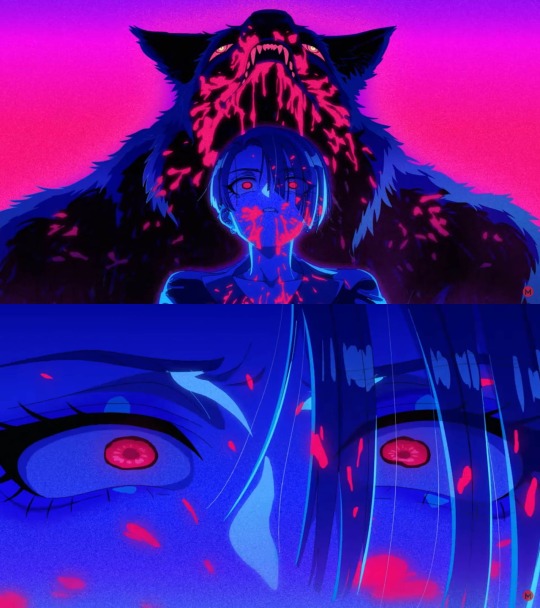
The wolf (both childhood trauma reminder and a representation of her violence here imo) haunting Kotoko. She also became the aggressor she hates so much like a lot of people pointed out, though in her case it's physical violence.
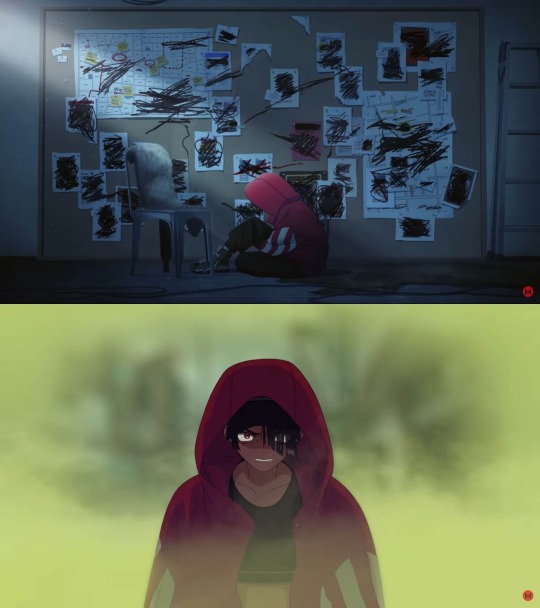
Kotoko doesn’t understand why she’s still not satisfied after dealing with all the criminals on her list and beating up the guilty prisoners. It could be because her trauma is still occupying her thoughts.
Many people have theorized that the girl with a pink shirt in Harrow could be Kotoko as a child. I completely agree with this, and it could be that Kotoko beat up Takao (the child kidnapper) to the point he died, because the orange dress girl’s situation reminded her so much of her past that she lost all control and killed him in the emotion (unlike the guy in the alley who she just beat up (iirc)).

Kotoko’s flashbacks while killing Takao (the car incident seems to have had an effect on her too).
A detail that’s a little strange is how the man in Kotoko’s flashback looks exactly the same as Takao (he’s even in the same outfit). It’s strange because Deep Cover confirms he’s 24 at the time Kotoko kills him, so he couldn’t be an adult if he was the one who hurt Kotoko as a child. Maybe she sees him as a stand-in for the person who traumatized her in the past?
As a side note, I think both the girl in a dress and the one in a pink shirt are Kotoko in the flashback. Maybe she changed clothes if she was kept captive for multiple days, and the floorboards look identical in both frames.
Some lyrics from Harrow that could refer to Kotoko’s past are these ones imo:
-I’ll teach you the pain you caused
→ as in the pain she suffered herself, hence why she feels like she has to punish criminals
- Becoming light-headed again, it all becomes crazy
The normalcy sought for, Fading away, Everytime death comes
The soul moves forward
and
Newly born “HARROW” “HARROW”
It’s ok to dislike, right?
Losing it, losing it, What should I hope for
Goodnight “HARROW” “HARROW”
Laugh and I can get to like myself
→ this could highlight how Kotoko constantly has something on her mind which makes her day to day life difficult (and that punishing criminals helps with it somewhat)
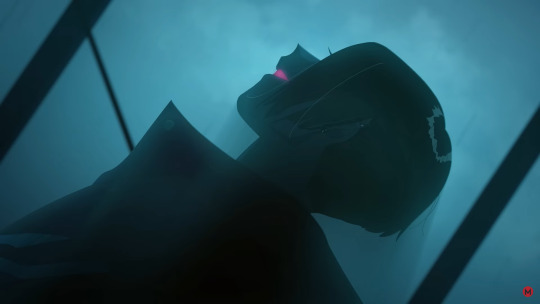
Kotoko’s self-hatred
If the theory about Kotoko’s childhood trauma is true, I feel like it could explain her general aggressiveness and dissatisfaction with life. Some lines in her mvs hint at her disliking herself too (“Feeding on food so I don’t burn out” etc).
“The feeling of being "cut-off" from peers and "emotional numbness" are both results of CSA and highly inhibit proper social functioning.” (source: https://en.wikipedia.org/wiki/Child_sexual_abuse)
(Since wikipedia isn’t always super reliable and I’m not an expert on the subject feel free to correct me if this is incorrect.)
Of course there are other explanations for this kind of behavior, but this info could potentially explain some things about Kotoko.
One thing is how Kotoko keeps her distance from the other prisoners in Milgram and isn’t really close with anybody, not even Kazui for example, who has the same hobby as her (training).
Other prisoners try to get to know her in timeline conversations , but she always stays placid and cuts the conversation short.
Mahiru: Hey, Kotoko-chan. There’s something that’s really been bugging me, so do you mind if I ask?
……how do you style yourself so well? Have you always dressed like that? But it also looks like something you’d wear for training. Do you play sport? Ah, or maybe some kind of martial arts?
Kotoko: ……you really are carefree. Everyone in here is a “murderer” right?
Is this really the time to be asking questions like that?
(tl by Rochisama)
Mikoto: Hey, hey, Koto-chan.
I’ve been thinking this ever since I first heard your name, but...
Don’t you think the names “Mikoto” and “Kotoko” kinda sound like siblings?
Kotoko: No.
Mikoto: Don’t say that!
Let’s get along well from here on as the Koto-Koto combo!
Kotoko: I’m not doing that.
(tl by Rochisama)
She could also just have an aloof personality by nature, but still wanted to point this out.
During Deep Cover, I feel like Kotoko’s diss on the other prisoners is mostly meant to show her own self-hatred rather than her dislike of the other prisoners (though this is definitely true as well).
It’s perfectly normal for someone to dislike some people, or a specific kind of people (like how she mentions disliking Mikoto because he’s loud). However, Kotoko goes well over all that and goes on a rant about each prisoner and their supposed faults in her eyes. In my opinion, it’s very strange that Kotoko dislikes All the other prisoners without exception, and to that degree.
Like said earlier, I think Kotoko’s obsession with justice and punishing “evildoers”, including people like Yuno, is not so much her caring about justice but a way for her to cope with her childhood trauma (Fuuta and his justice-seeking is also similar imo, though in his case my theory is that he was bullied in the past).
We see her beat up multiple people throughout Milgram, but so far her only confirmed victim is Takao. With the emphasis on her flashbacks when thinking about him in Harrow, Kotoko could have killed him instead of beating him up like said above, as his crimes were directly linked to her past experiences, and she couldn’t bring herself to stop before killing him.
I think Kotoko doesn’t really care about the other prisoners cases’ specifics in the end, she might be just searching for an excuse to prove to herself that she’s one of the “strong ones” who protect the weak, like she mentions to Es in her second vd and in a distorted line in one of the trailers:
“From the beginning I've never asked for your understanding! My actions, one by one, are bringing earth closer to peace. Useless Weaklings should just shut up and let me protect them!" (tl by milgram_en)
As in, she’s trying to prove all that to herself most and foremost.
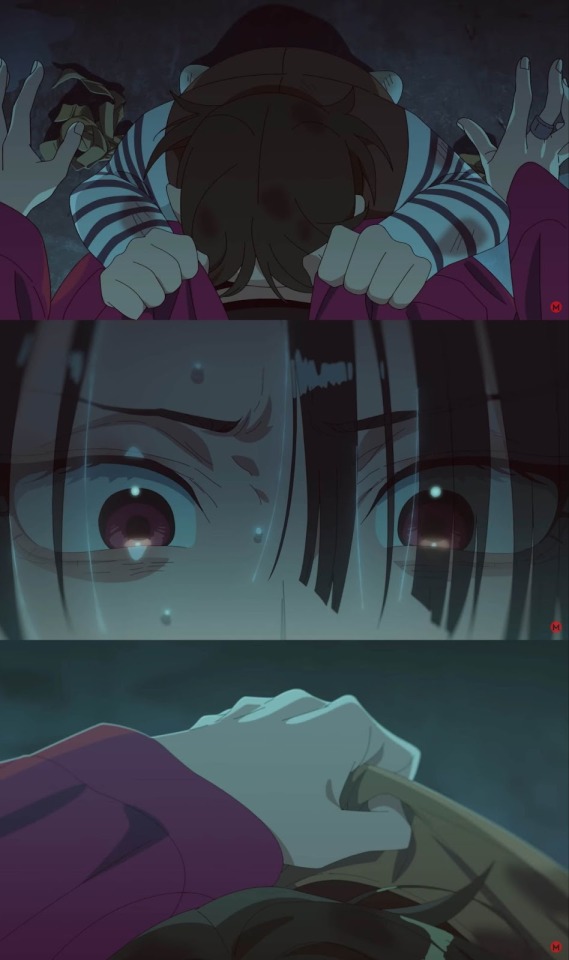
Why does Kotoko look so restless here? Of course she’s happy to rescue the girl, but why is she sweating so hard and grabbing the girl by the collar? In my opinion, this could be because she’s still shaken up from Takao’s killing (in the sense that she just killed the equivalent of the person who hurt her as a child, if we go with that theory). Maybe Kotoko sees herself in the orange dress girl, and she wishes someone had been there to save her too when it happened to her in the past.
It could be why she instinctively pushes the girl away (?) when she hugs her (though later in the mv we see they get along).
Another detail in Deep Cover that’s pretty interesting is the last line in the lyrics:
“They’re still here, still here, it grates me”
From the previous lines it’s implied she’s talking about the other prisoners, more specifically the innocent ones in T1. So they get on her nerves because they were incorrectly judged and couldn’t be punished by her (imo).
The Japanese line however is a lot more vague:
“ほら残ってさ 残ってさ 鬱雑いね”
The line means the same thing, except the subject isn’t made clear. So a literal translation could be like “X is still here, X is still here, it grates me”
The English translations are official so maybe I’m overthinking this, but maybe Kotoko could be talking about her thoughts here? This is a reach, but “X” might refer to flashbacks of her childhood trauma, especially if we go along with the theory that the wolf at the end of DC= Kotoko’s trauma personified. This is just speculation though.
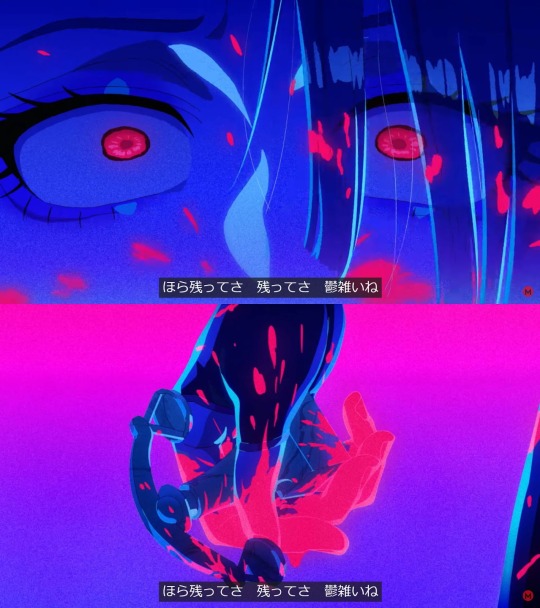
I feel like the subject in the last line being the wolf/Kotoko’s trauma could explain why she looks so distressed here, despite just having finished insulting the prisoners.
Plus, the next frame shows Kotoko’s chess piece being covered in blood/marked guilty like the other prisoners’. Imo this shows both Kotoko’s realization that she went too far with her “justice”, and that even after enacting it, she’s still not satisfied (because the real cause of her justice-seeking could be her trauma).
#can't wait to see Ktk's reaction to her verdict in T3#angry at her for beating up other prisoners but it's interesting to think about what could have led her to get her mindset#though it's hard to know for sure#milgram#milgram theory
23 notes
·
View notes
Text
Drow fashion, post-exposure period
Second half of the XVIth century :
-They would either wear clothes picked up from human corpses, usually shifts, hence there would be no major difference. Fishskin belts, loincloths and slippers would remain the same as in the previous era. As individuals did try to preserve and study the past to figure out how to survive the surface world, legwarmers would once again re-enter the picture. Macramé jewlery would return, but for bracelets only.
XVIIth century :
-Self-produced clothing would start appearing, with the re-intruduction of nettle and thristle cloth. It would retain the high necklines of the second half of XVIth century, but would adopt narrower, straight cut shoulders for easier layering and conserving fabric. To add additional production, thigh-high legwarmers and stockings made of the same material as the shift would be produced. The addition of rough, tow-woven "strings" to protect and "chastise" the private area would also start appearing, but only for adults. With time, rectangular necklines would appear, for fabric conservation. Fishskin slippers would slowly be traded for warmer fishskin mocassins covering more of the foot. Fishskin belts and loincloths would still be very prominant. With access to cloth, keeping the hair extremely long to use as a makeshift cape would no longer be necessary, and shorter hairstyles would appear, but only as women's fashion. The hair at the back would be cut slightly above the shoulders, while the bangs would be kept as long as possible and braided. As patriarchal ideals become more and more normalized, neckhair would be cut shorter and shorter as the century progress, until it reaching the earlobe. An exposed neck is seen as a sign of servility in their culture.
XVIIIth century : A generealisation of the square neckline. As wing mutilation decrease, slits would appear at the back of shifts as to let wings pass through. As the diplomatic class takes more and more power, and the necessity not to shock the sensibilities of the surrounding, non-Mouth of Hell human population would increase, fashion would respond. Men's legwarmers would become longer, so long that they are secured around the waist as opposed to the mid-thigh. Visible loincloths would dissapear, replaced by fishksin belt-skirts/ slitted cacheurs that serve the purpose of preventing the cloth covering the buttocks to become see-through in the case of rain. Men would start wearing detached collars at all times. Floffy bangs would also appear in men's fashion. For women, true skirts would appear for the first time, often made of tent canvas and kept slit on both sides. Drow sensibilities, dictating that youths, servants, slaves and childless married couples are ready for whipping do ensure that fashions completely covering the thighs and buttocks would never reach beyond the demography of wealthy adults.
2 notes
·
View notes
Text
The French used Roman numerals when indicating centuries in text (ie XVIth century) and this seems to me very...how you say...le retarded
19 notes
·
View notes
Text
So, this is that big post about my Faust/M&M/Fight Club/Hannibal universe I mentioned. I still hesitate on what I should call it (Faustverse? Devil club?)
Brainworms include:
1) My interpretation of Woland
2) Fight Club M&M AU
3) My interpretation of the master
4) Hannibal crossover
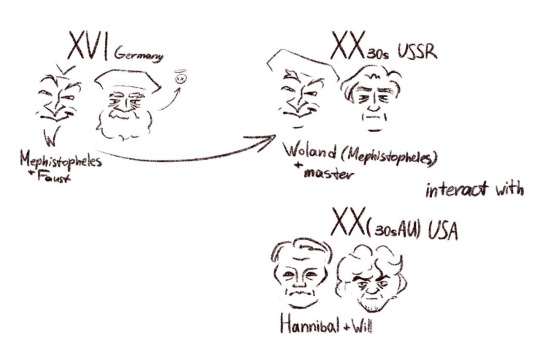
Woland is a character from a novel by Michail Bulgakov called “The master and Margarita”. He is heavily implied to be Goethe’s Mephistopheles and the novel itself is inspired by “Faust”. So these two books are on the same timeline (according to my headcannons).
My interpretation of Woland/Mephistopheles is that he is not a fallen angel, but is instead a part of Primordial Chaos from which God and his order were born. He disconnected from the main body some time ago and now exists in the material world as a force of entropy. He is neither good nor evil, but he is categorized as a demon because of his constant need to ensue chaos. He is not a part of Hell’s hierarchy and has a friendly relationship with God, because I don’t like when these type of characters lose their autonomy.
When he existed in the Primordial Chaos he was subjected to constantly changing powerful emotions and other extreme experiences and got used to them (iPad kid moment). So now, trapped in the more calm and organized environment, he is constantly bored and tries to replicate those experiences to feel something. He can feel all human emotions, but they are so mild for him, that he views them more like an annoying distraction, than actual feelings.
Woland doesn’t consider himself as a whole identity, but he looks and acts like one because he contrasts the environment opposite to his nature. So, technically, he wasn’t born so he isn’t afraid of death (he’ll disappear in a billion years or so)
In his free time he likes to find sad philosophers who are unsatisfied with their lives and manipulate them into something more entertaining. But it is pretty hard to find educated and ambitious people who are not attached to anybody and are willing to leave their previous lives behind (Faust was the last one and he got to heaven, so now he’s sitting there in a constant state of euphoria, lost his ambition and pride, essentially becoming a shell of himself)
Woland thought that having a couple legions of hell to help with his chaotic shenanigans would be good for his professional development, so in the beginning of the XVIth century he makes a deal with Lucifer to be in charge of hell for a couple of centuries and Lucifer agreed because he was drunk.
Elements of Fight Club in my M&M AU:
Margarita is not a part of the main plot. I have plans for her storyline, which would be pretty similar to the original with her becoming a witch, but with different motivations and more character development.
Woland interacts with the master without his servants. I have a 9000 word fanfic written in russian about their first encounter.
Here’s the link: https://archiveofourown.org/works/57835000/chapters/147206677
For those who don’t speak russian here’s a short summary. It is important, because most of my M&M fanart depicting the master is based on the Fight Club AU, rather than on the actual events (boring straight romance with him being a depressed self insert without any depth).
In a nutshell the master is an apathetic historian/archivist whose whole life is based on his work in the Moscow Planetarium, which isn’t enjoyable anymore, but the rest of the world is even more undesirable. He exists in a sort of coma, feeling nothing, reading and writing instinctively with professionalism but without any interest.
Then he meets Woland, gets in an existential crisis, gets fired, attempts to jump off a bridge, gets interrupted by Woland, attacks him in resentment and they fight. Master experiences true anger for the first time. They end up lying on the ground, covered in dust and blood, laughing at each other. Later they agree to meet again and to repeat the fight. Sergei Berdyaev (the master) rejects his name and Woland suggests that he could go by the name Steingut (a kind of clay, the symbol of an ongoing rebirth).
After that Steingut wins a lot of money in a lottery (very very coincidentally totally not demonic help), so he stops worrying about working and just waits for Woland’s return, admiring his bruises and blood stains on his clothes.
But Woland doesn’t appear for weeks. Steingut's body is almost recovered and he is starting to forget the memories connected to those injuries, which deeply terrifies him. He feels incomplete, feels like he is going insane sitting in a room alone with nobody to talk to and nothing to do.
He decides to write down the events that shaped him, but realizes that he is unworthy of mentioning someone of that significance directly. By doing that he would defile the truth and its importance with his subjective judgment. So he switches up the names and writes about the director of Variety theater and his administrator fighting because of a misunderstanding, later organizing “The Fighting citizens club” together.
Only after he finishes writing, he hears a whisper in his ear asking him what he wanted to achieve with this story. “I wanted to survive” the master finishes his rebirth exhausted and sleep deprived. Woland treats him to dinner. As a reward Woland offers the master to make a wish. He wishes for Woland to visit him more often. They make plans to plant a copy of the master’s book on the table of the real administrator of Variety theater to see what would happen.
So, let’s talk about the master (Sergei Berdyaev -> Steingut -> the master):
After the rebirth the master’s main goal is to survive. But his meaning of “surviving” was warped into “constantly moving and changing”, so in that sense being around Woland is the perfect way to survive. But if Woland decides to spend time with someone, they need to be intelligent and entertaining. Because of that the master is always scared of not being enough, so he has to constantly educate himself to come up with interesting ways to ensue chaos. This time Woland stumbled not on a sad philosopher, but on an intelligent animal desperately trying to adapt.
He doesn’t strive for much, but he is willing to go to great lengths to achieve his survival.
The master is terrified of Woland just as much as he dreads Woland’s absence. He is very careful with his words around him, which Woland is annoyed by. To get rid of the master’s cowardice Woland angers him. Then the master becomes petty and forgets that he is speaking with someone so powerful and dangerous, which in turn leads to more meaningful and truthful interactions.
Fun fact: the master is unaware that his main goal is to survive. He thinks he is constantly moving and changing because he is looking for a purpose (because it is a more normal thing to do). There would be a separate fic about him realizing that through extreme chaos exposure. He goes through literal torture willingly just to prove Woland wrong (with Woland still being right in the end).
Woland plans to destroy the master’s desire for purpose, leaving with just a strong desire to live while believing that there is nothing worth living for.
And then get him into heaven. Like, if heaven is all about unchanging bliss, than the master who technically fought the Devil and lived without that much sin could get there and be immune to this pleasant hipnosis. He could be the only one awake and cause all sorts of trouble (even unwillingly).
The master isn’t aware of this scheme and doesn’t even want to go to heaven because of his incompatibility with peace and absence of change.
Hannibal crossover stuff:
Use of technology is not crucial to the plot of Hannibal so 1930s AU is pretty reasonable. It happens after the end of the series, everyone is alive and well, just in hiding. Hannibal would try to kill the master for ruining an opera performance as part of their own show with Woland, but he doesn’t know about Woland’s existence yet.
Another fun fact: Hannibal canonically admires Mephistopheles and despises Faust.
So Hannibal stalks the master and attacks him in his living room, the master fights back with Woland sitting behind the dining table unnoticed. He telepathically warns the master about surprise attacks but doesn’t intervene because he knows that the master likes the adrenaline.
When both opponents are tired and can’t fight anymore he stands up and politely apologizes for the inconvenience they caused in the opera, inviting Hannibal and Will for dinner.
All of them meet each other soon enough. Hannibal can’t stop fangirling over Woland (Meph) and both the master and Will are jealous. The master and Will bond over their attachment to their literal and metaphorical devil and the stress involved in caring so much about him. The master still dislikes Hannibal for trying to kill him over a prank, but Hannibal noticed enough similarities with Will to change his mind. Woland is intrigued with all of them equally, planning to turn their relationship into endless entertainment.

I hope you enjoyed reading this abomination! I’ll post my Woland/ the master fanart soon. Feel free to leave your opinions and suggestions in the comments!
6 notes
·
View notes
Text
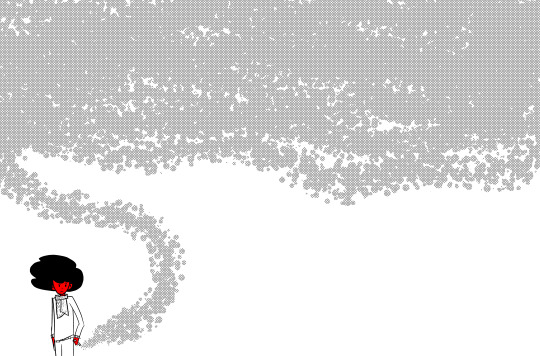
This is the Buddy for March 10th. There's a lot of smoke there. At first I was toying with making the image even taller, like ten times the size, so that most of it was covered in smoke, but decided to go with this one. A real coin toss, really.
On an unrelated point, I heard about Akira Toriyama's death yesterday. Pretty sad, considering he was still comparatively young (68) and active. I was a huge Chrono Trigger fan when I was young, and I've played that game through the end several times. Best RPG of its generation.
I also liked Dragon Ball, although not as much, and that love kind of diminshed with age. Still, I've got a lot of nostalgia for the Z era sagas, with Freeza and Cell. And I read the manga, the early years with kid Goku were pretty interesting, too.
Unfortunately, after the Boo saga the franchise kind of went off-rails. Wasn't into the anime-only GT series, not to mention the games or the disastrous movie. The Super series wasn't as bad, but still doesn't compare to the original.
Still, I have real fond memories of the story. It's an interesting and unique story - or at least it would be if it wasn't so incredibly popular it became ingrained into everyone's mind and imitated to such an extent. I'm reading Osamu Tezuka's Boku no Son Goku, which was also inspired by Journey to the West, and this time I can say Tezuka's work wasn't the superior adaptation. Of course, you have to consider the context...
It's hard to explain a lot about Dragon Ball, especially to people who aren't fans. It started out as a comedic parody of a XVIth century novel, but then it turned into a martial arts story, and then it became serious? And the main character grew up, dozens of minor characters piled up in the background... and all of that before the twist that started the story I'm familiar with - Goku's an alien?
Toriyama's art made the story a lot more pleasant, too. The design of vehicles, aliens, monsters and robots was top notch, and what made me enjoy the story much more than the fight scenes and associated cliches. Another interesting thing was Toriyama's use of twists which led the stories into a different direction when compared to other shonen manga, which often adhered religiously to the build-up to stronger enemies in sucession.
But that's also where the story issues lie. The first is the bloated cast of characters being humiliated so Goku could steal the spotlight. The biggest victim there is Yamcha, but, really, everyone who was beaten by Goku then turned good was kind of cannon fodder. That started as a twist, too - so this evil guy Goku had so much trouble with got beaten so easily by the new villain? Damn. And since new villains kept being introduced, each one being so much stronger than the last, it was hard to make sense of how strong the characters were (and any realism was already out the window thanks to all the plot devices keeping the characters alive and strong enough to fight).
It's funny by the end of the story - or even, by the end of the kid Goku era already - the dragon balls were also relegated to the background. I don't like a lot of the cliches of the series, the plot devices used to make characters stronger with no interesting consequences, the convoluted use of elements of past stories, annoying character behaviors... but, still, you have to respect a guy who managed to start out with such a weird little comedy with its goofy looking vehicles and talking dinosaurs, and turn it into a behemoth so popular, people can have such strong feelings about it.
RIP, Akira Toriyama.
#ab4es#drawing#smoke#cigarette#Akira Toriyama#Chrono Trigger#Dragon Ball#Dragon ball Z#Boku no Son Goku#Osamu Tezuka#Goku#Son Goku#Dragon Ball GT#Dragon Ball Super#Journey to the West
5 notes
·
View notes
Text






Claidheamh dà làimh dhubh
A Black Claymore, in the West Highland style, second half of the XVIth century.
Inspired by a variety of surviving examples, this one shows the classic features of the type, with quadrifoils at the end of the downturned quillions of strong rhombic section, fileworked central langets, hollow pommel and top finial. The swelling on the grip is inspired by the sword kept at the Kelvingrove Museum in Glasgow and is leather over wood - most grips visible in such swords nowadays are modern replacements.
Fittings are mild steel, oil-blacked.
The engraved blade is spring steel, made after the various examples of German productions.
See Tony Willis, "the Scottish Two-Handed Sword", Bulletin of the American Society of Arms Collectors 120, pp. 35-69.
Overall length is 1405 mm, blade is 1020 mm long and 45 mm wide, and shy of 5.4 mm thick at its base.
Cross span is 145 mm.
Weight is 1809 grams, point of balance 17 cm from the cross.
Again, sharing from here will only share this picture, so if you want to share the intire set of photos, do it from my Dr Fabrice Cognot, Phd, Bladesmith Page
Thanks
141 notes
·
View notes
Text

“So-Called Damascus Pottery, XVIth century” c.1933
12 notes
·
View notes
Text
WIP Wednesday
Thank you @greypetrel for the tag <3



1 - 2: The OC Symbolism thingy is taking longer than anticipated, but I'm almost there? Malva (Surana) is pretty much done, Gwydion (mHawke, already posted the wip) only misses the big fancy portrait, while Maren (fHawke) is... Err, definitely a work in progress.
3: I have some "everything is the same but with more accurate-ish XVIth century fashion" sketches. Also: first time I draw Fenris and it's with landsneckt inspired outfits because he is technically a mercenary? I'm so sorry.
Tag time! Maybe @pinkfadespirit? As usual, no pressure 🌸
8 notes
·
View notes
Text
Right. So about South's name and the fact there's 'South' and 'Temple' kanji in it.
At the very start Christian missionary (and Japanese Christians) practice their religion in 南蛮寺; Nanba-ji. (reminder: South Terano; 南 寺野). 南蛮, 'Nanban' means 'South Barbarians' and was used to describe Japan neighbor countries at first (Southern China, Southern Asia, Ryukyu Islands...). But then it got used to describe European foreigners - mostly Portuguese people (explorers, missionaries, merchants). The word 南蛮 isn't commonly used in Japan nowadays
Not saying Portuguese and Brazilian people are the same but in the XVIth century, Portuguese-speaking people in Brazil were the colonizers
Anyway that's the only thing I found about South's name for now (the face he shares the same '-no' as 'Sano' aside)
12 notes
·
View notes
Text
Costumes in London in the years 1590 and 1640.
Costumes of England. 16th and 17th century. On the history of costumes. Hundred and Fourth Sheet. England. XVIth and XVIIth century. Münchener Bilderbogen No. 1180. London 1590. Distinguished women. Merchant and merchant’s wife. Officer.London 1590. Merchant’s wife. Servant. Burgess wife. England 1640. Lady in the street. Burgher’s wife. Lord Manors wife. Matron. Source: Münchener Bilderbogen…
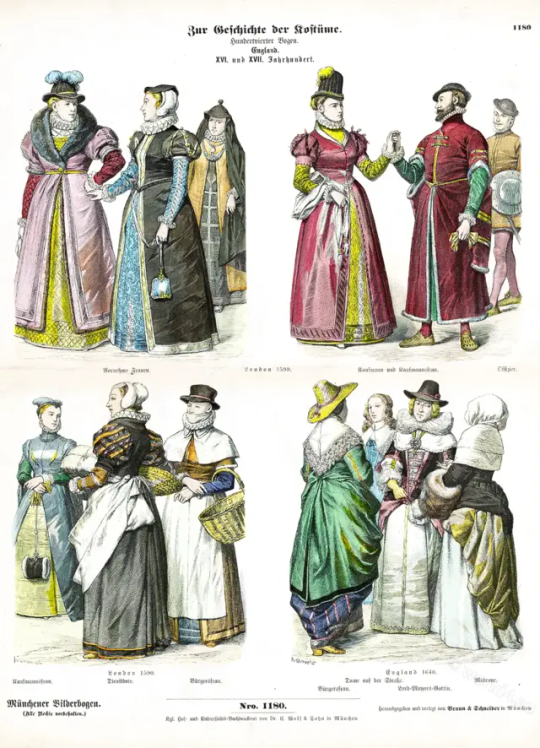
View On WordPress
3 notes
·
View notes